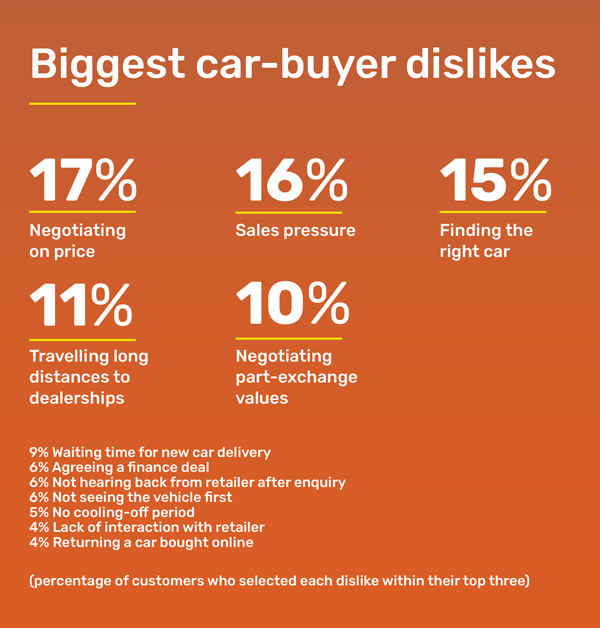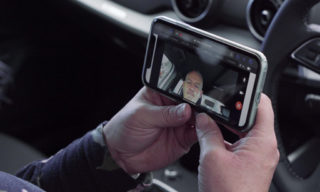In every part of retail, customer expectations are changing, and car buying is no exception to this. In a world where competition between dealerships for custom is just as strong as ever, it’s those who can deliver the smooth, hassle-free experiences customers want that will stand out from the crowd.
In one of our recent blogs, we featured what car buyers like from the retail experience – but what about the things they don’t like? Our recent research highlighted what customers disliked about their previous car buying experience, and this blog we’ll explore the top five – and how to avoid them.
Biggest car-buyer dislikes:
- Negotiating on price: 17%
- Sales pressure: 16%
- Finding the right car: 15%
- Travelling long distances to dealerships: 11%
- Negotiating part-exchange values: 10%
- Waiting time for new car delivery: 9%
- Agreeing a finance deal: 6%
- Not hearing back from retailer after enquiry: 6%
- Not seeing the vehicle first: 6%
- No cooling-off period: 5%
- Lack of interaction with retailer: 4%
- Returning a car bought online: 4%
(percentage of customers who selected each dislike within their top three)

Negotiating on price
Negotiating on price was cited as the top most disliked part of the experience, with one in six listing it among their top three (or should that be bottom three?) factors. This could be for a number of reasons, among them being that many people find open discussion about money uncomfortable, especially when concerning the relatively large sums that can be involved in a vehicle purchase. Others may be inexperienced with negotiation and therefore lack confidence.
A good solution to this is to introduce personalised video at an early stage of the customer journey. That way, before price negotiation is even considered, the customer has built an emotional engagement with the vehicle and feels more confident in getting the right car at the right price for them. It also provides the chance for customers to start building a relationship with the sales executive before they even set foot in the dealership.
Sales pressure
Connected to the previous point, car sales are still affected to some extent by the outdated stereotype of salespeople putting customers under pressure in order to secure a purchase. This can cause some people to shy away from situations where they’re engaged in face-to-face contact with a sales executive. The recent challenges with new and used car stock may negate a lot of this as demand is outstripping supply, but it is still a perception that may need to be overcome.
Video can be used to help you build a trusted relationship, one where the customer feels that they have much more control over proceedings. Customers can find out about their prospective purchase, or receive an update from a sales executive, in their own time and place. This means that, by the time they first step through the dealership door, they already know who they’re dealing with and what to expect, and feel confident that they’re in good hands.
Finding the right car
As a customer, the process of identifying the right car for your needs can be time-consuming, and also daunting with the number of different options and considerations to be taken into account. This, however, is an area where the showroom experience can play a major role in lightening the burden. We know more of the journey is taking place online at the beginning, however the ability to have direct contact with a product expert is still a major part of the car buyers experience.
By positioning themselves as expert partners, sales executives can help customers making enquiries by providing them with a shortlist of options that may fulfil all or most of their top priorities. Customers can then view these vehicles in person, or through informative walkaround videos, helping them to stay engaged and feeling like they can rely on the sales executive for fair advice. Live video can also play a part here, providing face-to-face contact before the customer comes to the showroom. By enabling a direct line of conversation the customer can get immediate answers to questions and it also enables that relationship to start forming much earlier in the process.
Travelling long distances to dealerships
Although online car retail is becoming more popular, many customers still prefer to enquire about a car in person. In our recent survey, 44% said they would still choose to visit the dealership.

However, a long journey time to visit a dealership can act as a deterrent, especially if customers feel they have to give up a major portion of their day to view a car they may not even necessarily be interested in. The ideal alternative for these customers is to virtualise the in-person viewing experience, through Live Video appointments and Desktop sharing, which can give them enough insight and detail to place a deposit virtually. They will then be able to commit to a dealership visit to follow-up, safe in the knowledge that the car is right for them.
Negotiating part exchange values
Negotiation that can often take place when customers trade in a car for part exchange is not an area that car buyers look forward to. Understandably, customers want to get the best deal possible, which can lead them to over-value their car. Likewise, we know retailers are often faced with a part exchange vehicle not quite in the condition described by the owner.
Clarity and transparency can make part exchange a smoother, less stressful experience for both parties, and that’s exactly where solutions like Tootle can help. Customers can add in their expected valuation and utilising cap hpi data if the car is being overvalued an instant notification is shown. In pilot sites, 100% of customers who were alerted that they overvalued their vehicle then reduced their asking price to within the suggested valuation , thus eliminating the awkward ‘negotiation’ aspect of part exchange and not damaging the relationship between the salesperson and customer. With the added ability to also submit a full report of their vehicle it makes the appraisal process clear for the customer and takes out the verbal negotiation which can have a negative effect on the buying process.
In 2022 and beyond, car buying experiences are set to be defined by the consumer. CitNOW solutions can help to enhance the customer experience, improving sales and customer retention. To learn more about crafting the perfect customer journey free of irritation and inconvenience, download our Ultimate Digital Customer Journey report.





